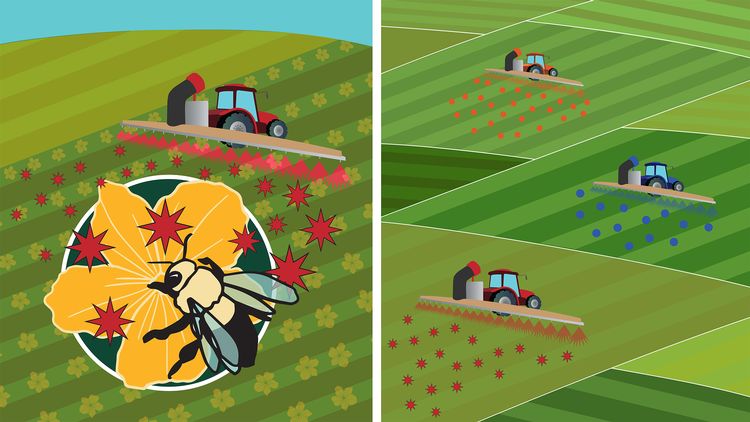Apr 13, 2021All hands needed to protect wild bee pollinators
Wild and honeybees pollinate many of the crops we eat. Each farmer’s field is part of a larger agricultural landscape where bees forage and collect nectar throughout the area, potentially visiting a variety of crops. How might pesticide exposure across multiple fields be impacting bees? The answer and solutions lie in all of us working together.
Michigan State University entomologists joined with colleagues at Purdue University and the Ohio State University to drill in for more answers about landscape effects studying pollination in 87 pumpkin, cucumber or watermelon (cucurbit) farms in the Midwestern U.S. Their findings were recently published in the Journal of Applied Ecology, “Synergism between local- and landscape-level pesticides reduces wild bee floral visitation in pollinator-dependent crops.”
The team evaluated if fungicide and insecticide use posed a hazard to wild and honey bees and whether pesticide use in one cucurbit field and surrounding crop fields combined to influenced bee visitation to crop flowers.
These combinations of pesticides are particularly important because mixtures of pesticides can interact, or synergize, to cause greater harms to bees than single pesticides used alone.
“We found that bees were exposed to pesticides above regulatory levels of concern and that synergisms between a few local insecticides and landscape level fungicides reduced wild bee visitation to cucurbit flowers,” said Elias Bloom, lead author on the publication and a post-doctoral researcher with MSU Entomology associate professor Zsofia Szendrei.
Many cucurbits, including those in the study, benefit from wild pollinators and these benefits sometimes cannot be provided by honey bees. For example, honey bees can be good pollinators for some cucurbits like cucumbers, but some crops like pumpkins benefit from special wild bees called squash bees.
“Changing pesticide use practices appears to promote these wild bees that are really important for pollination in some of these crops,” said Bloom. “A multifaceted approach with collaborations between farmers, consumers and policymakers is needed to promote changes in pesticide use and better support wild bee pollinators.”
Watch this video to see the importance of native bees to many fruit and vegetable crops, a critical piece of our food supply.
This project was funded by USDA NIFA grant numbers 2016-51181-25410 and 2017-68004-26323.
– Joy Landis, Michigan State University















